Response of Freshwater Lenses to Precipitation and Tides
Abstract
1. Introduction
2. Study Area
2.1. Overview of the Study Area
2.2. Water Quality Observation Methods
3. Study on Freshwater Lens Simulation
3.1. Model Construction
3.2. Selection of Basic Parameters of the Model
3.3. Setting of Model Boundary Conditions
3.4. Principle of Model Calculation
3.5. Conversion Relations and Simulation Schemes
4. Study on the Response of Island Groundwater to Rainfall and Tides
4.1. Study on Conductivity Response of Island Groundwater
4.2. Simulation Study on the Influence of Rainfall and Tides on the Freshwater Lens
5. Conclusions
- (1)
- The groundwater conductivity of coral islands shows periodic fluctuation. Tidal level changes control the fluctuation periodicity of groundwater conductivity. The temporal distribution of precipitation controls the peak value of groundwater conductivity, with the peak value becoming higher as the precipitation becomes more temporally concentrated. The closer to the shoreline, the higher the chloride concentration of groundwater and the greater the impact of tides on the groundwater chloride concentration.
- (2)
- Observed data at different time scales have different usefulness. If the key issue to address is the overall trend of a freshwater lens, monthly observation data may be used. If the key issue to address is the periodicity in the changes in a freshwater lens, hourly observation data may be used. If the research focus is to investigate both simultaneously, daily observation data may be used. Moreover, an accurate conversion formula and fast conversion formula between seawater conductivity and salinity are obtained.
- (3)
- During the formation of a freshwater lens, precipitation mainly affects the chloride concentration of groundwater, whereas the tidal level mainly affects the groundwater hydraulic head pressure at various points in the groundwater aquifer.
- (4)
- The stabilization time point and steady-state chloride concentration of a freshwater lens are mainly controlled by precipitation factors. The more temporally invariant the precipitation, the higher the desalination degree in the freshwater lens and the larger the freshwater storage. In the numerical simulation, a failure to consider temporal precipitation changes results in a simulation error of 19.23% and 74.15% in the stabilization time point and steady-state chloride concentration of the freshwater lens, respectively. The steady-state groundwater hydraulic head is more affected by tides than by precipitation, but neither has a great impact, with errors of only 0.16–0.23%.
- (5)
- The larger the minimum time scale of the boundary conditions in the numerical simulation, the greater the error in the simulation results. Time scales have little effect on the stabilization time point and steady-state hydraulic head of the fresh groundwater lens, with simulation errors of only about 2.5%. Time scales have a great impact on the steady-state chloride concentration of the freshwater lens, with simulation errors of 82.29–97.09% at the daily and monthly scales.
Author Contributions
Funding
Data Availability Statement
Conflicts of Interest
References
- Zhao, M.X.; Yu, K.F.; Shi, Q.; Chen, T.R.; Zhang, H.L.; Chen, T.G. Coral Communities of the Remote Atoll Reefs in the Nansha Islands, Southern South China Sea. Environ. Monit. Assess. 2013, 185, 7381–7392. [Google Scholar] [CrossRef] [PubMed]
- Wang, R.; Shu, L.; Zhang, R.; Ling, Z. Determination of Exploitable Coefficient of Coral Island Freshwater Lens Considering the Integrated Effects of Lens Growth and Contraction. Water 2023, 15, 890. [Google Scholar] [CrossRef]
- Chui, T.F.M.; Terry, J.P. Influence of Sea-Level Rise on Freshwater Lenses of Different Atoll Island Sizes and Lens Resilience to Storm-Induced Salinization. J. Hydrol. 2013, 502, 18–26. [Google Scholar] [CrossRef]
- Post, V.E.A.; Houben, G.J.; van Engelen, J. What Is the Ghijben-Herzberg Principle and Who Formulated It? Hydrogeol. J. 2018, 26, 1801–1807. [Google Scholar] [CrossRef]
- Post, V.E.A.; Bosserelle, A.L.; Galvis, S.C.; Sinclair, P.J.; Werner, A.D. On the Resilience of Small-Island Freshwater Lenses: Evidence of the Long-Term Impacts of Groundwater Abstraction on Bonriki Island, Kiribati. J. Hydrol. 2018, 564, 133–148. [Google Scholar] [CrossRef]
- Werner, A.D.; Sharp, H.K.; Galvis, S.C.; Post, V.E.A.; Sinclair, P. Hydrogeology and Management of Freshwater Lenses on Atoll Islands: Review of Current Knowledge and Research Needs. J. Hydrol. 2017, 551, 819–844. [Google Scholar] [CrossRef]
- Vacher, H. Dupuit-Ghyben-Herzberg Analysis of Strip-Island Lenses. Geol. Soc. Am. Bull. 1988, 100, 580–591. [Google Scholar] [CrossRef]
- Falkland, A. Hydrology and Water Management on Small Tropical Islands. In Hydrology of Warm Humid Regions; Gladwell, J.S., Ed.; International Association Hydrological Sciences: Wallingford, UK, 1993; pp. 263–303. [Google Scholar]
- Werner, A.D.; Bakker, M.; Post, V.E.A.; Vandenbohede, A.; Lu, C.; Ataie-Ashtiani, B.; Simmons, C.T.; Barry, D.A. Seawater Intrusion Processes, Investigation and Management: Recent Advances and Future Challenges. Adv. Water Resour. 2013, 51, 3–26. [Google Scholar] [CrossRef]
- Stoeckl, L.; Houben, G. Flow Dynamics and Age Stratification of Freshwater Lenses: Experiments and Modeling. J. Hydrol. 2012, 458–459, 9–15. [Google Scholar] [CrossRef]
- Sonnenborg, T.O.; Hinsby, K.; van Roosmalen, L.; Stisen, S. Assessment of Climate Change Impacts on the Quantity and Quality of a Coastal Catchment Using a Coupled Groundwater-Surface Water Model. Clim. Change 2012, 113, 1025–1048. [Google Scholar] [CrossRef]
- Schneider, J.C.; Kruse, S.E. Assessing Selected Natural and Anthropogenic Impacts on Freshwater Lens Morphology on Small Barrier Islands: Dog Island and St. George Island, Florida, USA. Hydrogeol. J. 2006, 14, 131–145. [Google Scholar] [CrossRef]
- Underwood, M.; Peterson, F.; Voss, C. Groundwater Lens Dynamics of Atoll Islands. Water Resour. Res. 1992, 28, 2889–2902. [Google Scholar] [CrossRef]
- Terry, J.P.; Falkland, A.C. Responses of Atoll Freshwater Lenses to Storm-Surge Overwash in the Northern Cook Islands. Hydrogeol. J. 2010, 18, 749–759. [Google Scholar] [CrossRef]
- Chui, T.F.M.; Terry, J.P. Modeling Fresh Water Lens Damage and Recovery on Atolls After Storm-Wave Washover. Ground Water 2012, 50, 412–420. [Google Scholar] [CrossRef]
- Chui, T.F.M.; Terry, J.P. Groundwater Salinisation on Atoll Islands after Storm-Surge Flooding: Modelling the Influence of Central Topographic Depressions. Water Environ. J. 2015, 29, 430–438. [Google Scholar] [CrossRef]
- Comte, J.-C.; Banton, O.; Join, J.-L.; Cabioch, G. Evaluation of Effective Groundwater Recharge of Freshwater Lens in Small Islands by the Combined Modeling of Geoelectrical Data and Water Heads. Water Resour. Res. 2010, 46, W06601. [Google Scholar] [CrossRef]
- Holt, T.; Greskowiak, J.; Seibert, S.L.; Massmann, G. Modeling the Evolution of a Freshwater Lens under Highly Dynamic Conditions on a Currently Developing Barrier Island. Geofluids 2019, 2019, 9484657. [Google Scholar] [CrossRef]
- Jazayeri, A.; Werner, A.D.; Irvine, D.J. Transience of Riparian Freshwater Lenses. Water Resour. Res. 2022, 58, e2021WR031310. [Google Scholar] [CrossRef]
- Panthi, J.; Boving, T.B.; Pradhanang, S.M.; Russoniello, C.J.; Kang, S. The Contraction of Freshwater Lenses in Barrier Island: A Combined Geophysical and Numerical Analysis. J. Hydrol. 2024, 637, 131371. [Google Scholar] [CrossRef]
- South China Sea Map. Available online: https://ar.inspiredpencil.com/pictures-2023/south-china-sea-map (accessed on 20 March 2025).
- Buddemeier, R.W.; Oberdorfer, J.A. Chapter 22—Hydrogeology of Enewetak Atoll. In Developments in Sedimentology; Vacher, H.L., Quinn, T.M., Eds.; Geology and Hydrogeology of Carbonate Islands; Elsevier: Amsterdam, The Netherlands, 2004; Volume 54, pp. 667–692. [Google Scholar]
- White, I.; Falkland, T. Management of Freshwater Lenses on Small Pacific Islands. Hydrogeol. J. 2010, 18, 227–246. [Google Scholar] [CrossRef]
- Ayers, J.; Vacher, H. Hydrogeology of an Atoll Island—A Conceptual-Model from Detailed Study of a Micronesian Example. Ground Water 1986, 24, 185–198. [Google Scholar] [CrossRef]
- Singh, V.S. Evaluation of Groundwater Resources on the Coral Islands of Lakshadweep, India, 1st ed.; Springer: New York, NY, USA, 2016; ISBN 978-3-319-50072-0. [Google Scholar]
- Jocson, J.M.U.; Jenson, J.W.; Contractor, D.N. Recharge and Aquifer Response: Northern Guam Lens Aquifer, Guam, Mariana Islands. J. Hydrol. 2002, 260, 231–254. [Google Scholar] [CrossRef]
- Lin, J.; Snodsmith, J.B.; Zheng, C.; Wu, J. A Modeling Study of Seawater Intrusion in Alabama Gulf Coast, USA. Environ. Geol. 2009, 57, 119–130. [Google Scholar] [CrossRef]
- Chen, K.R.; Chen, H.B.; Zhao, H.L. Numerical simulation of seawater intrusion based on SEAWAT. J. Water Resour. Water Eng. 2012, 23, 140–145. (In Chinese) [Google Scholar]
- Oberle, F.K.J.; Swarzenski, P.; Storlazzi, C.D. Atoll Groundwater Movement and Its Response to Climatic and Sea-Level Fluctuations. Water 2017, 9, 650. [Google Scholar] [CrossRef]
- Barkey, B.L.; Bailey, R.T. Estimating the Impact of Drought on Groundwater Resources of the Marshall Islands. Water 2017, 9, 41. [Google Scholar] [CrossRef]
- Sheng, C.; Han, D.; Xu, H.; Li, F.; Zhang, Y.; Shen, Y. Evaluating Dynamic Mechanisms and Formation Process of Freshwater Lenses on Reclaimed Atoll Islands in the South China Sea. J. Hydrol. 2020, 584, 124641. [Google Scholar] [CrossRef]
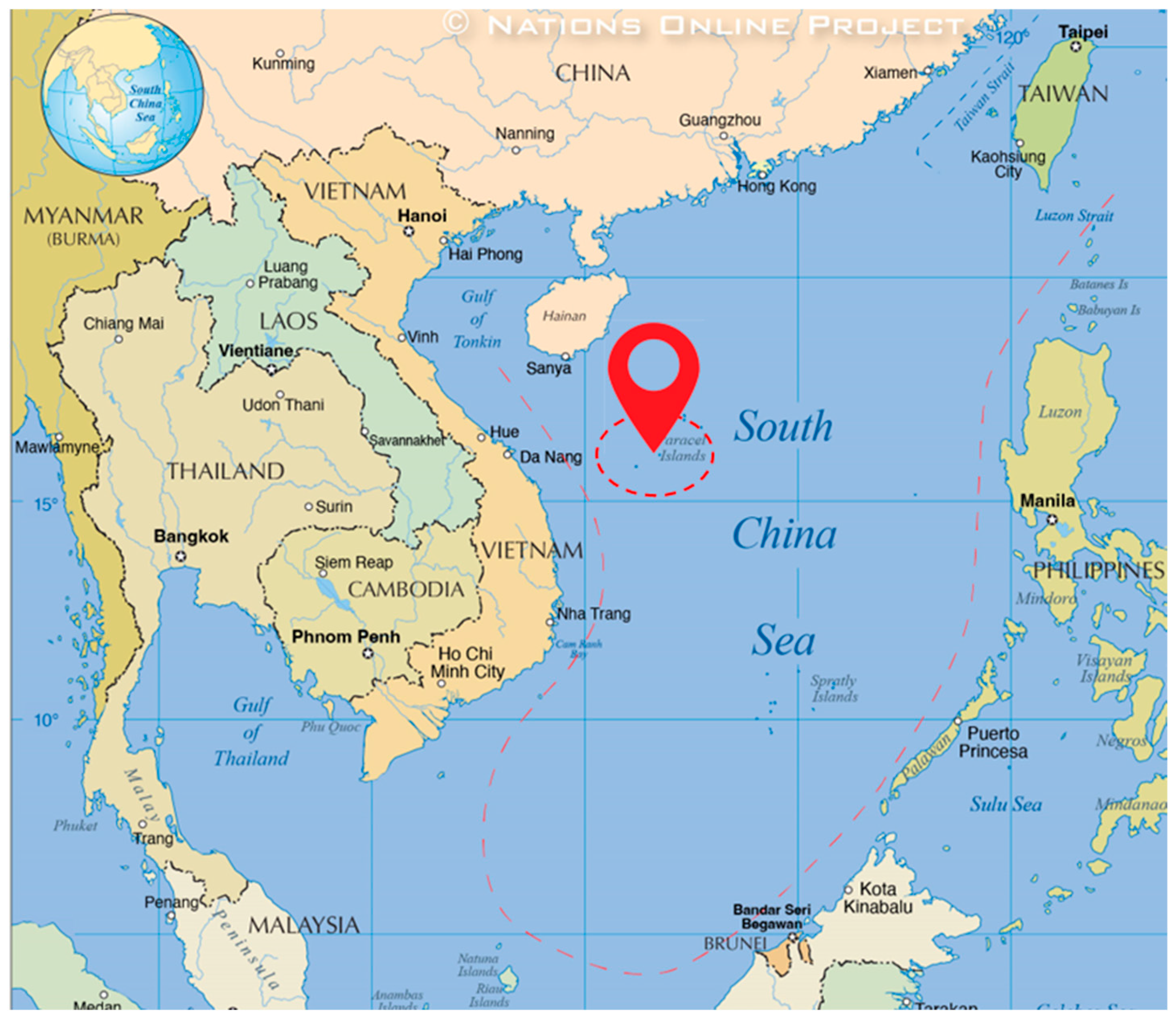
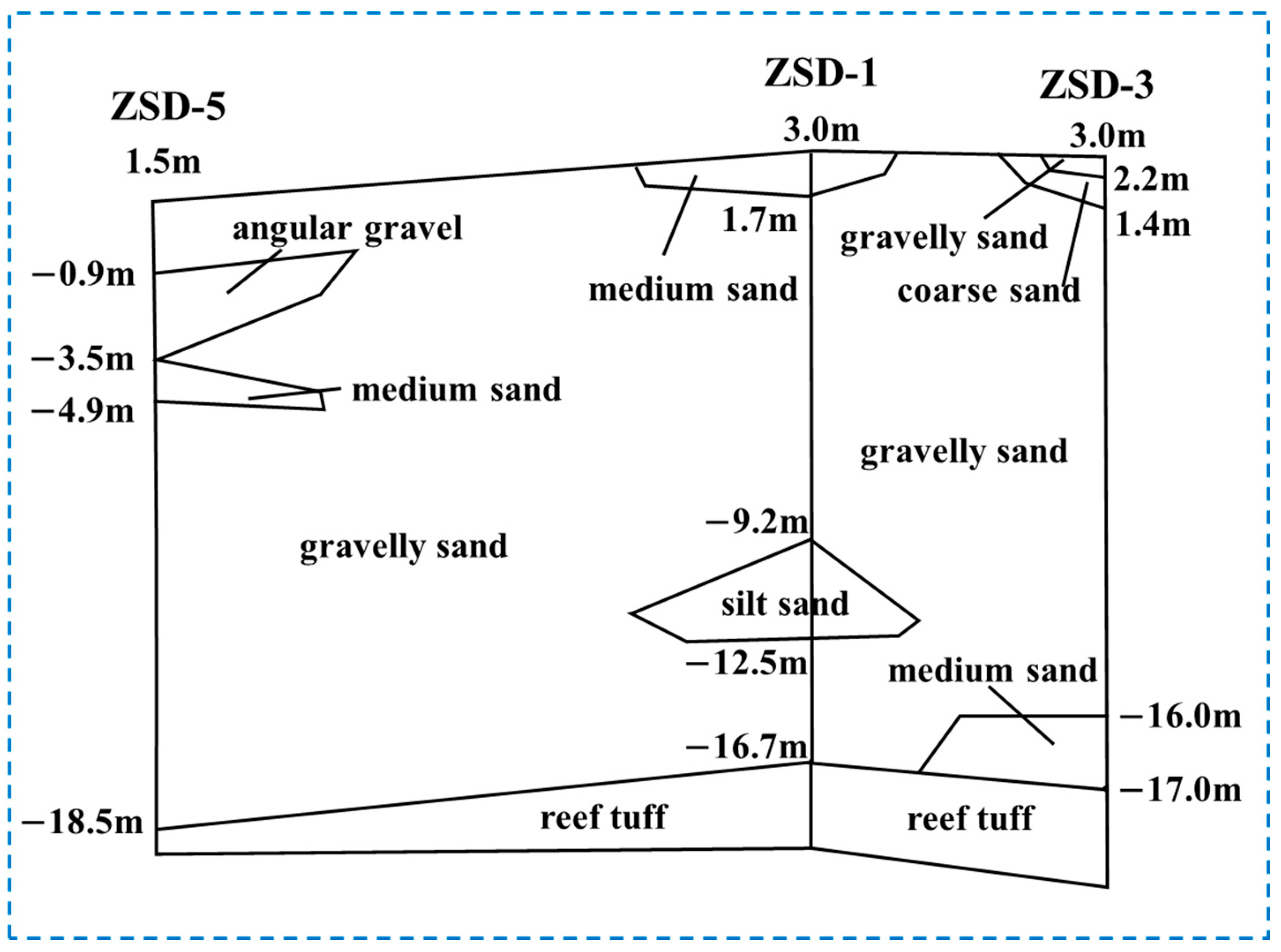
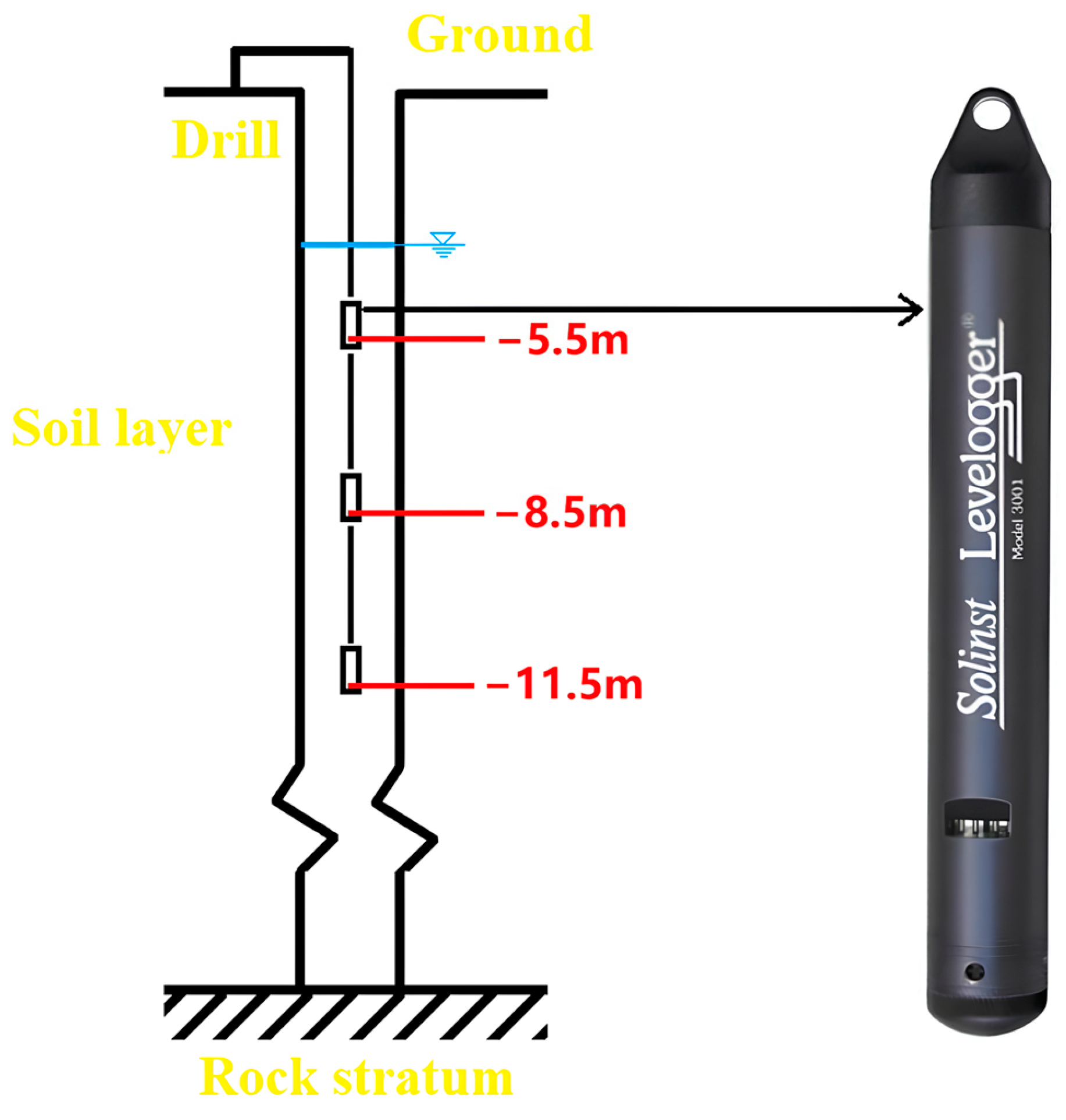
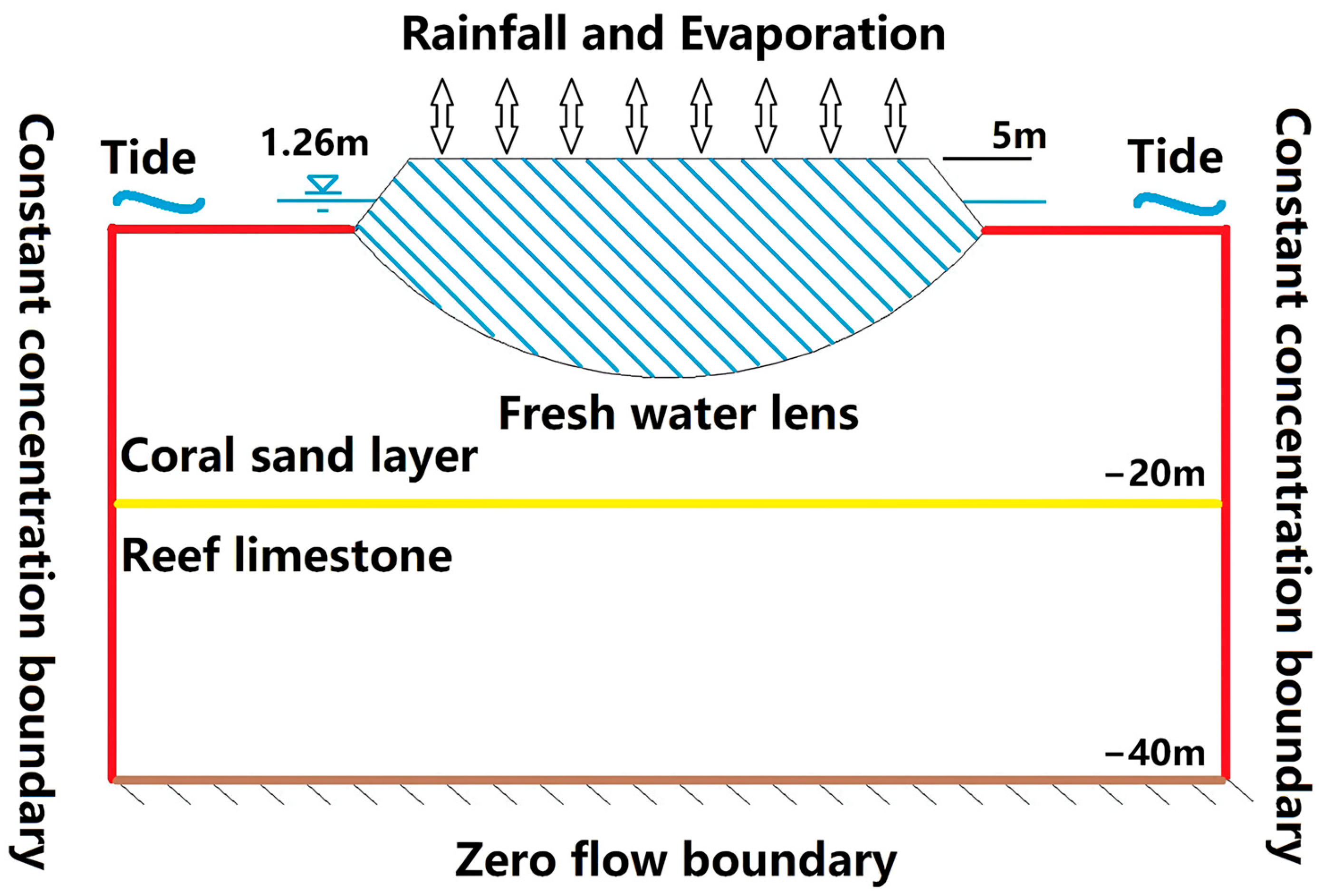
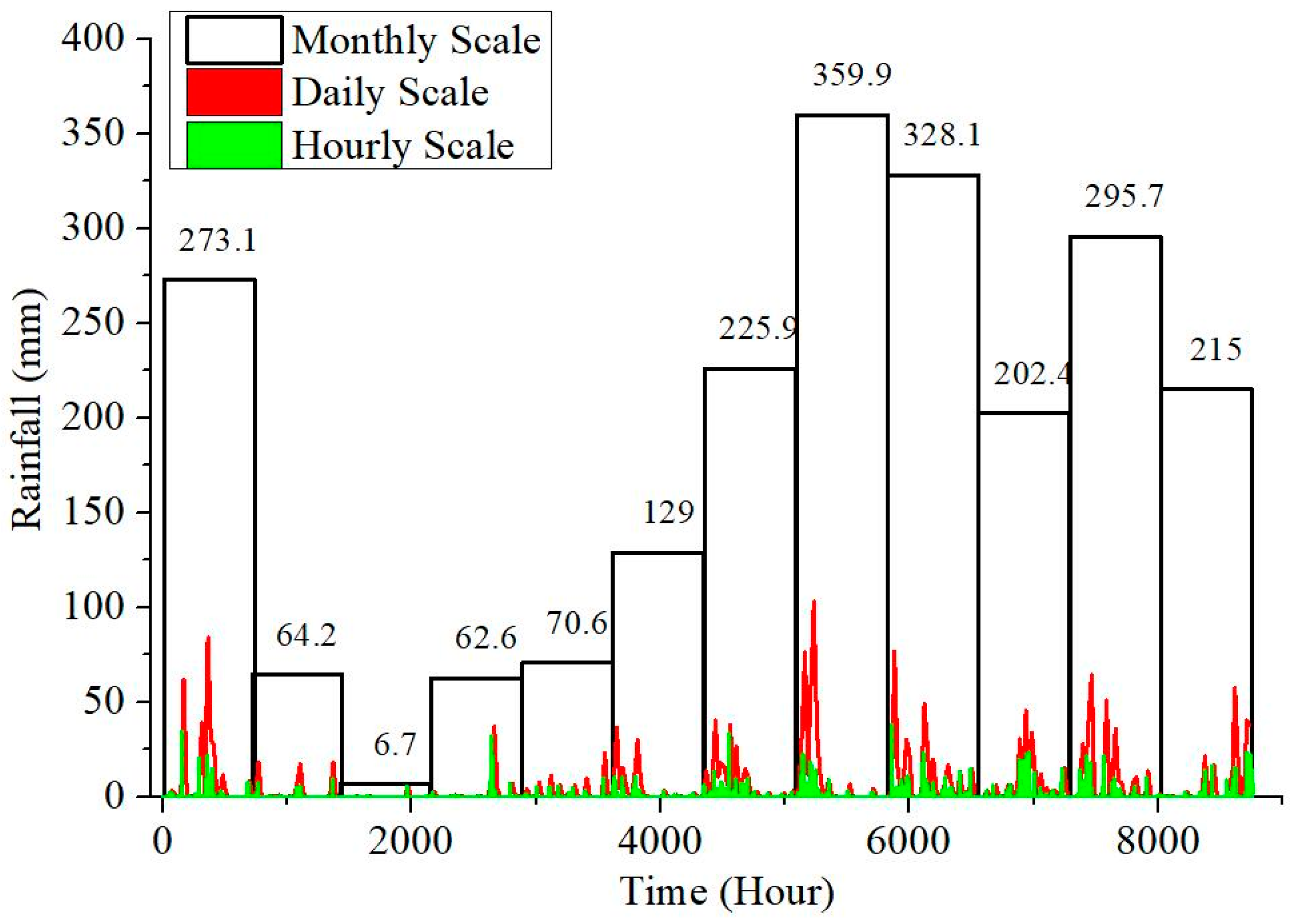
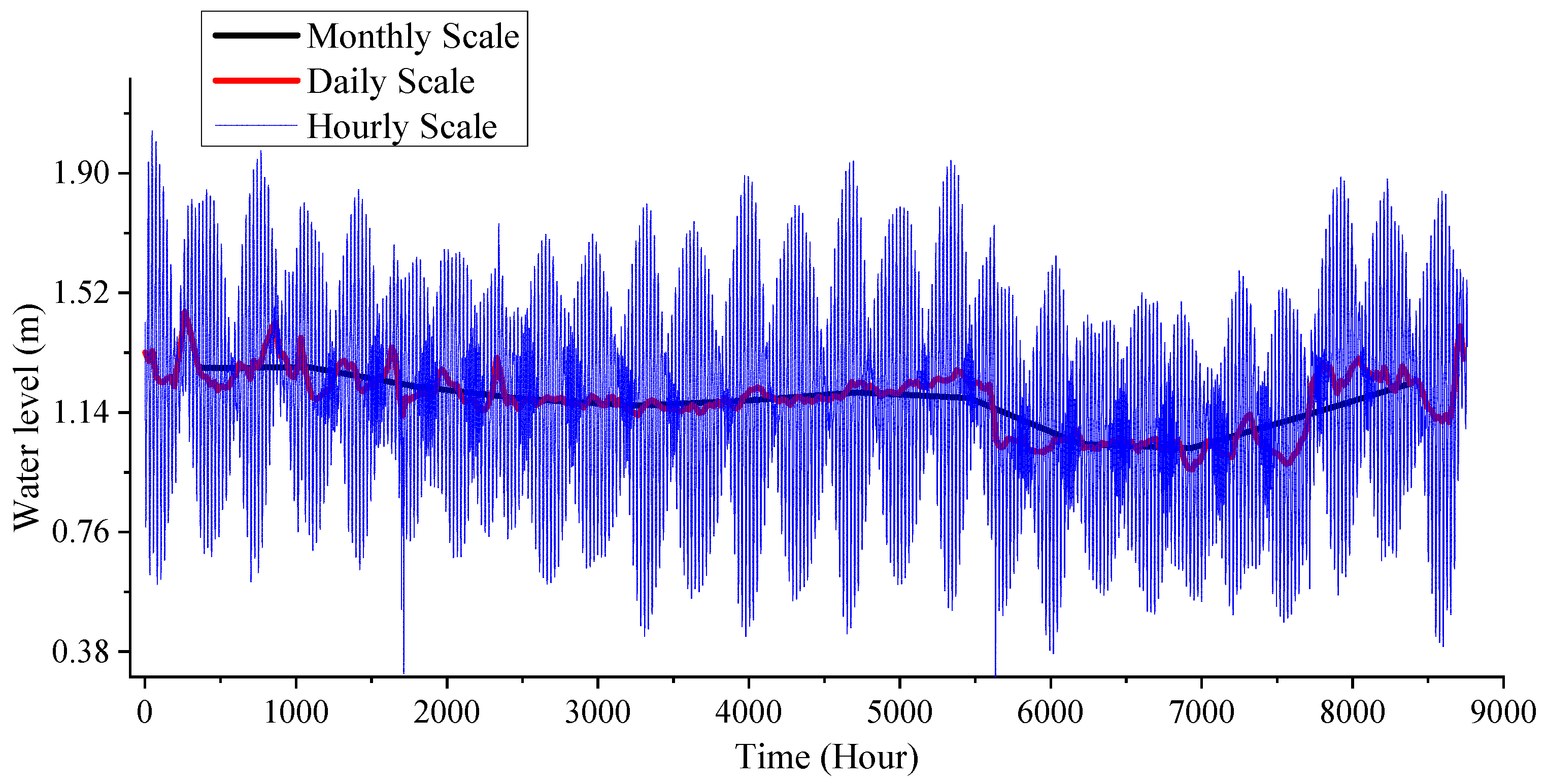
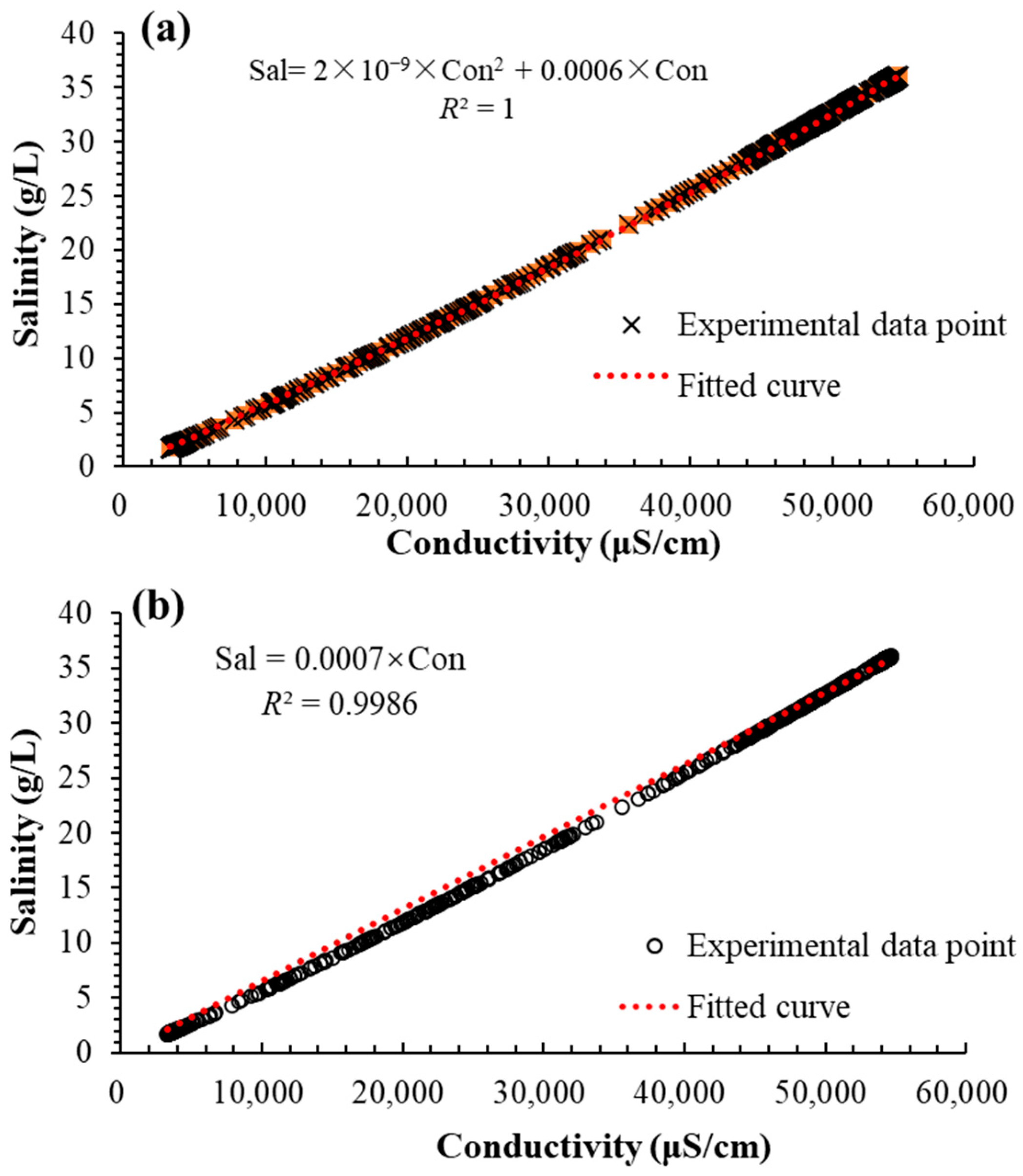
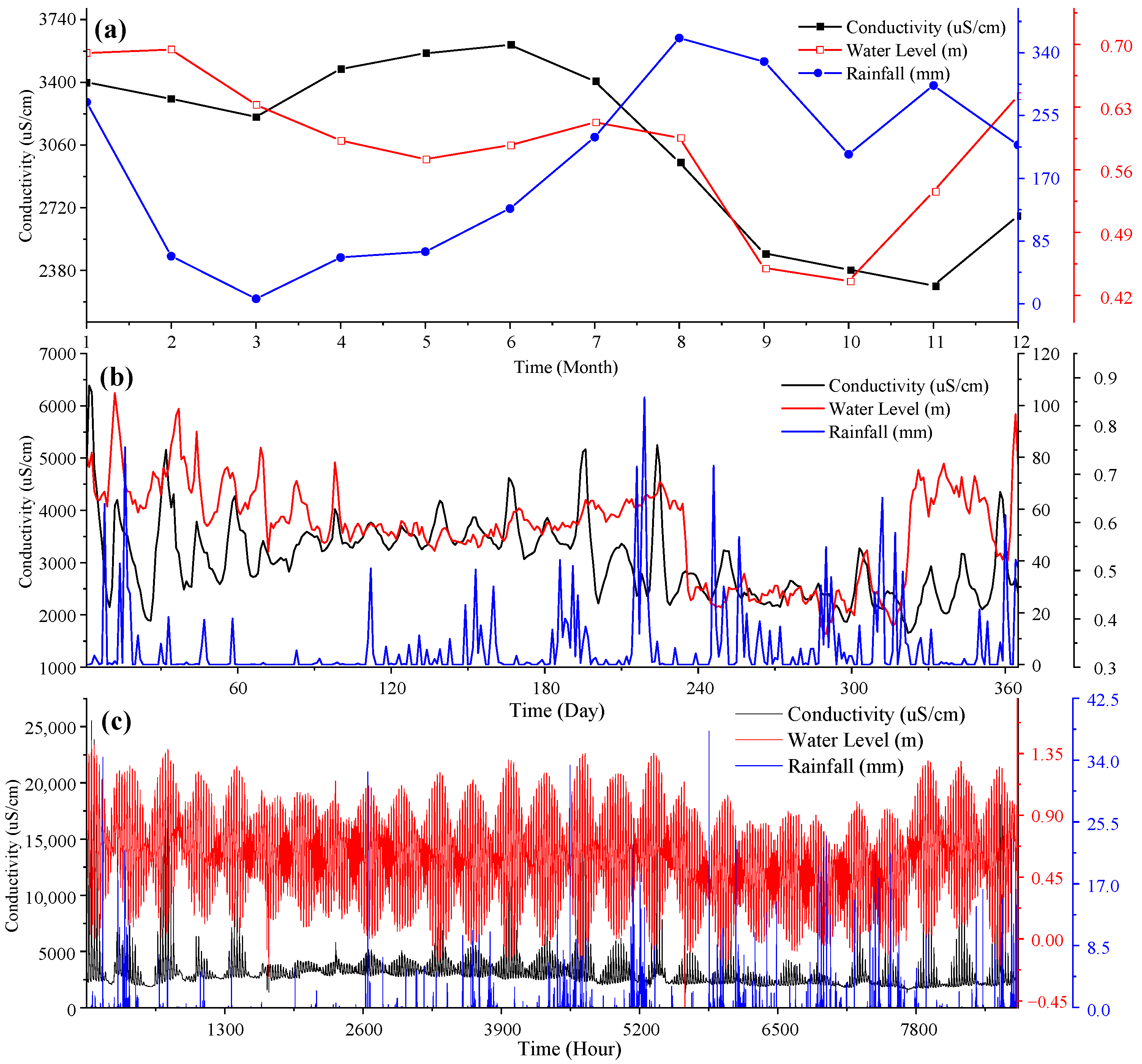

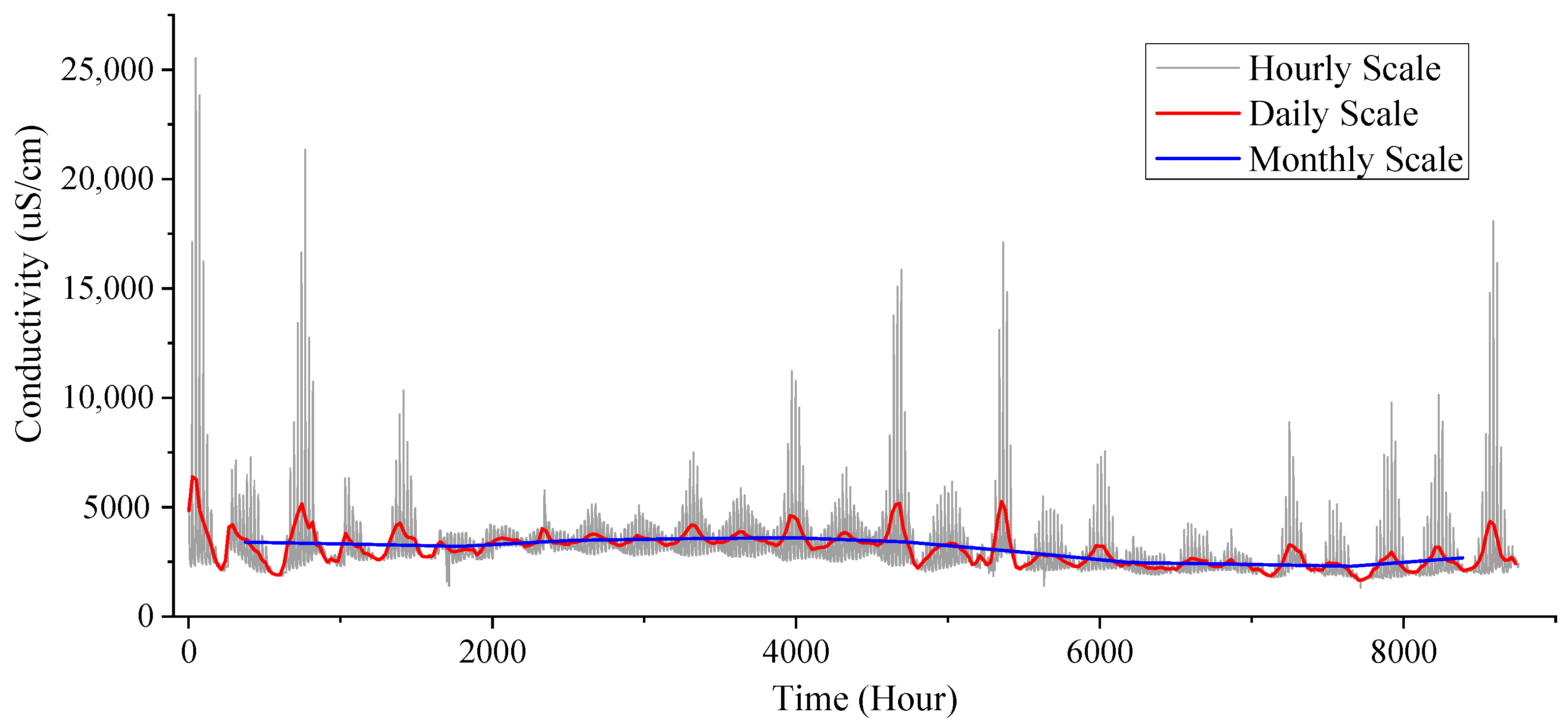

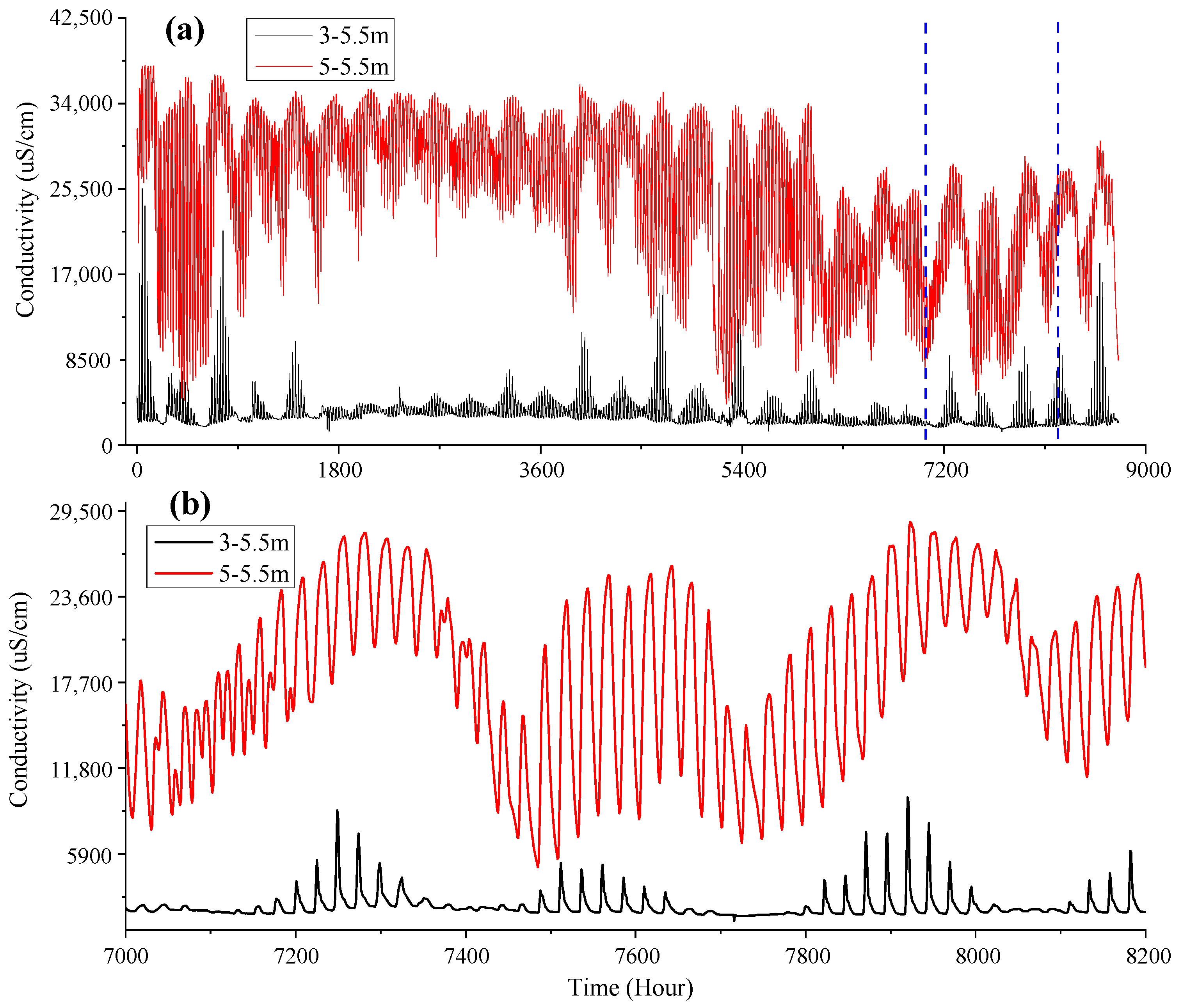
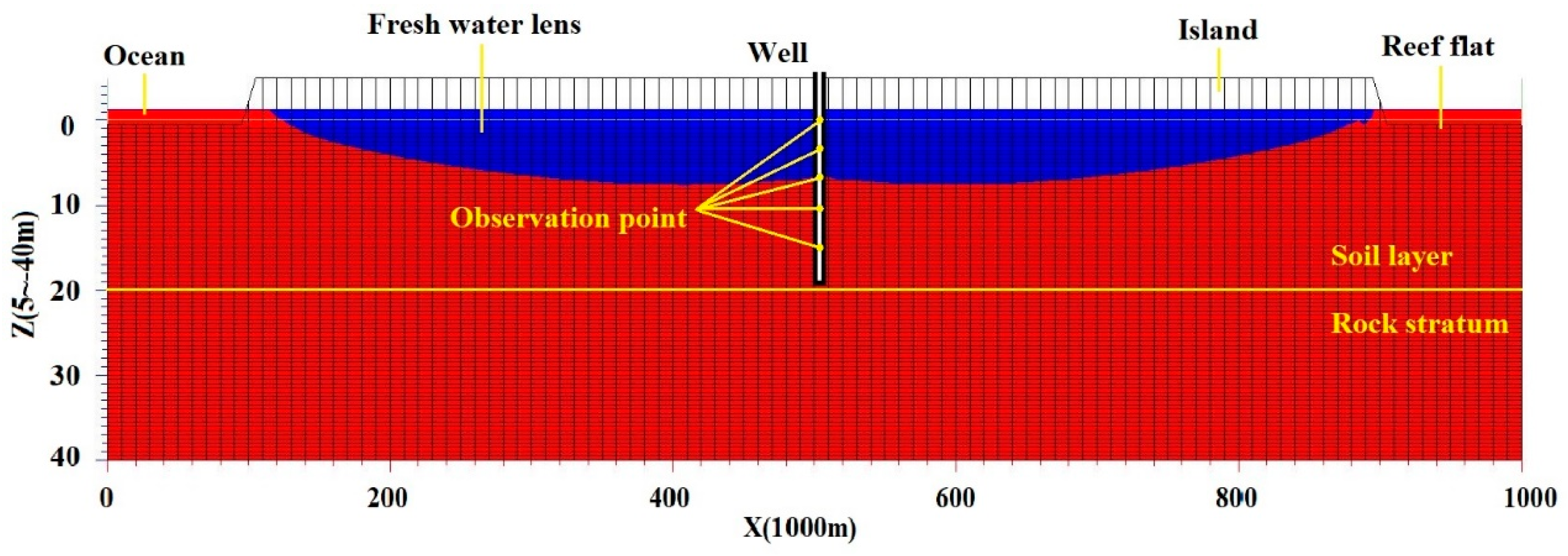
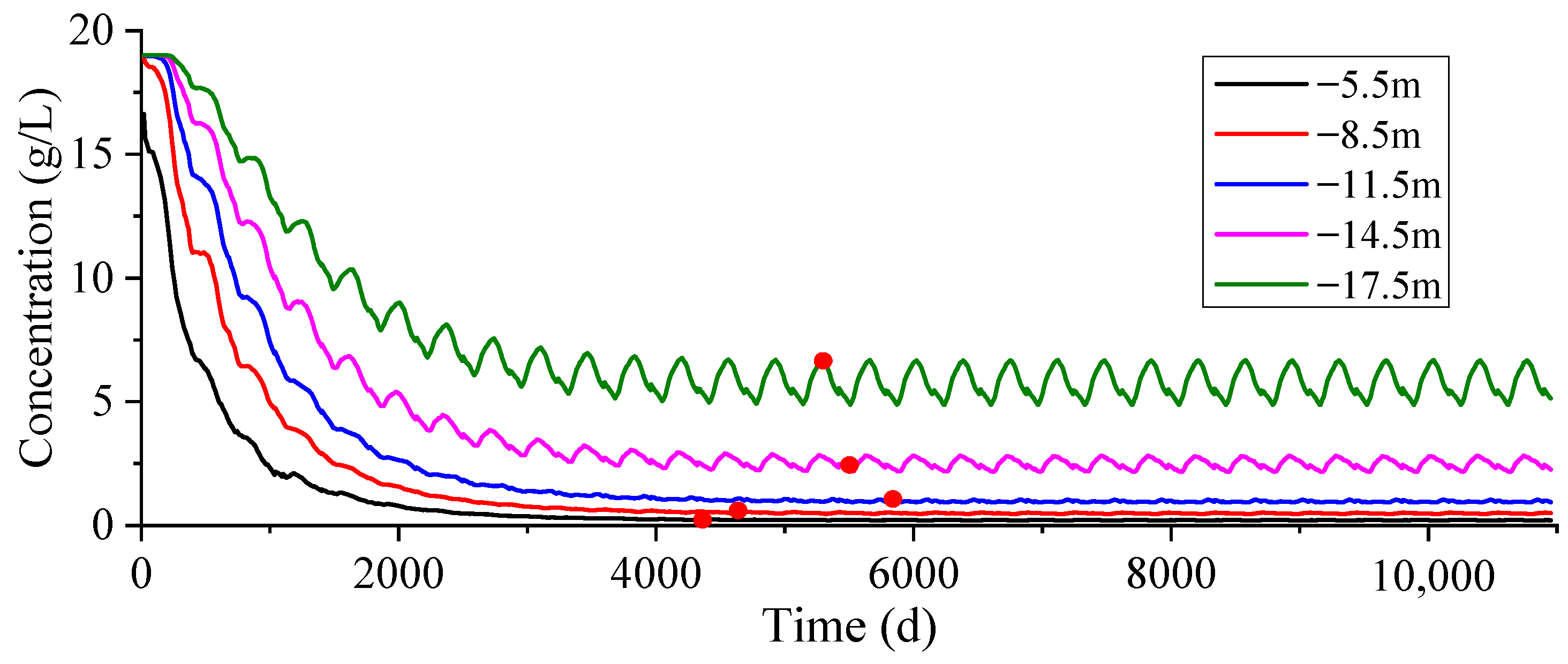
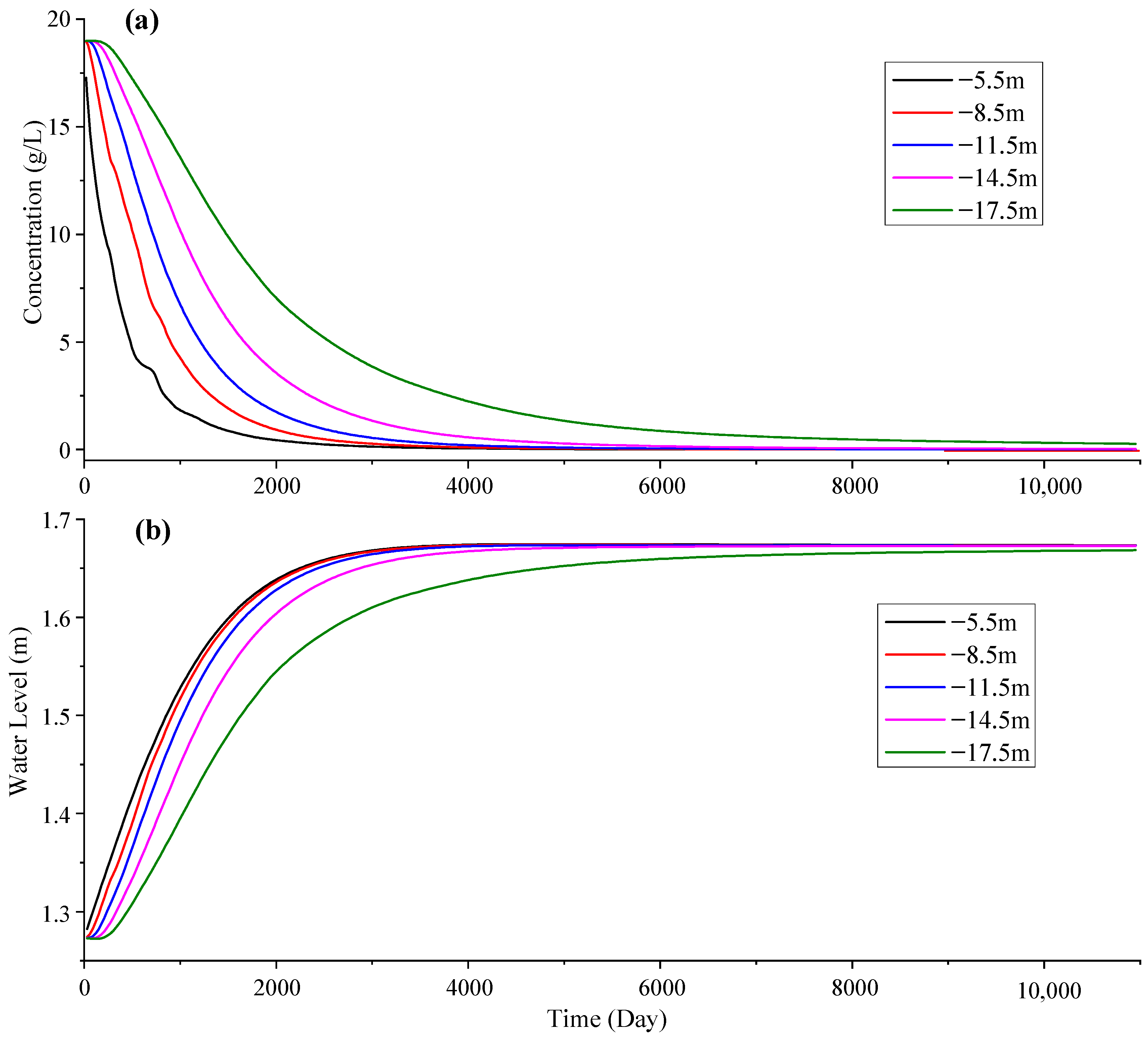

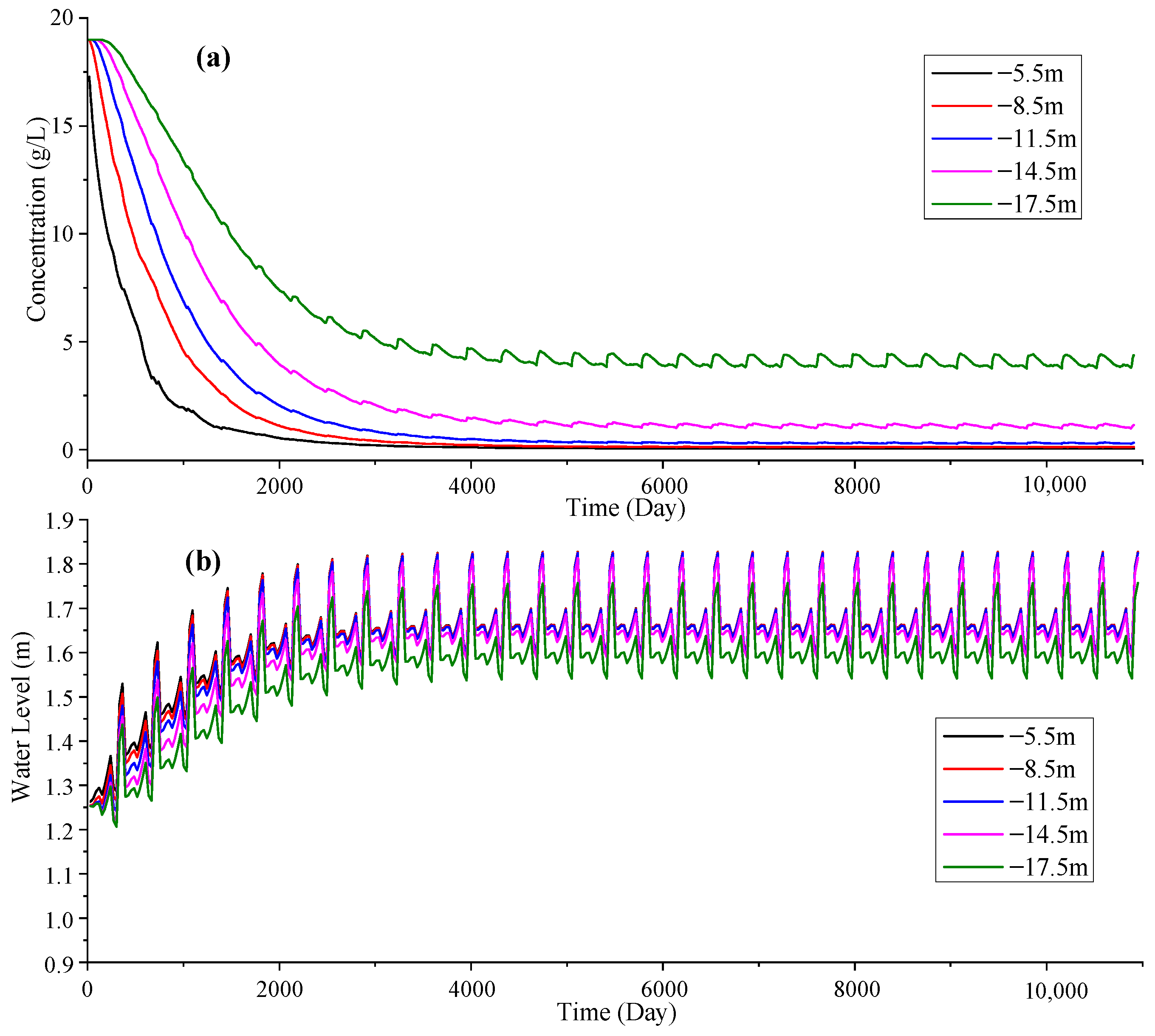

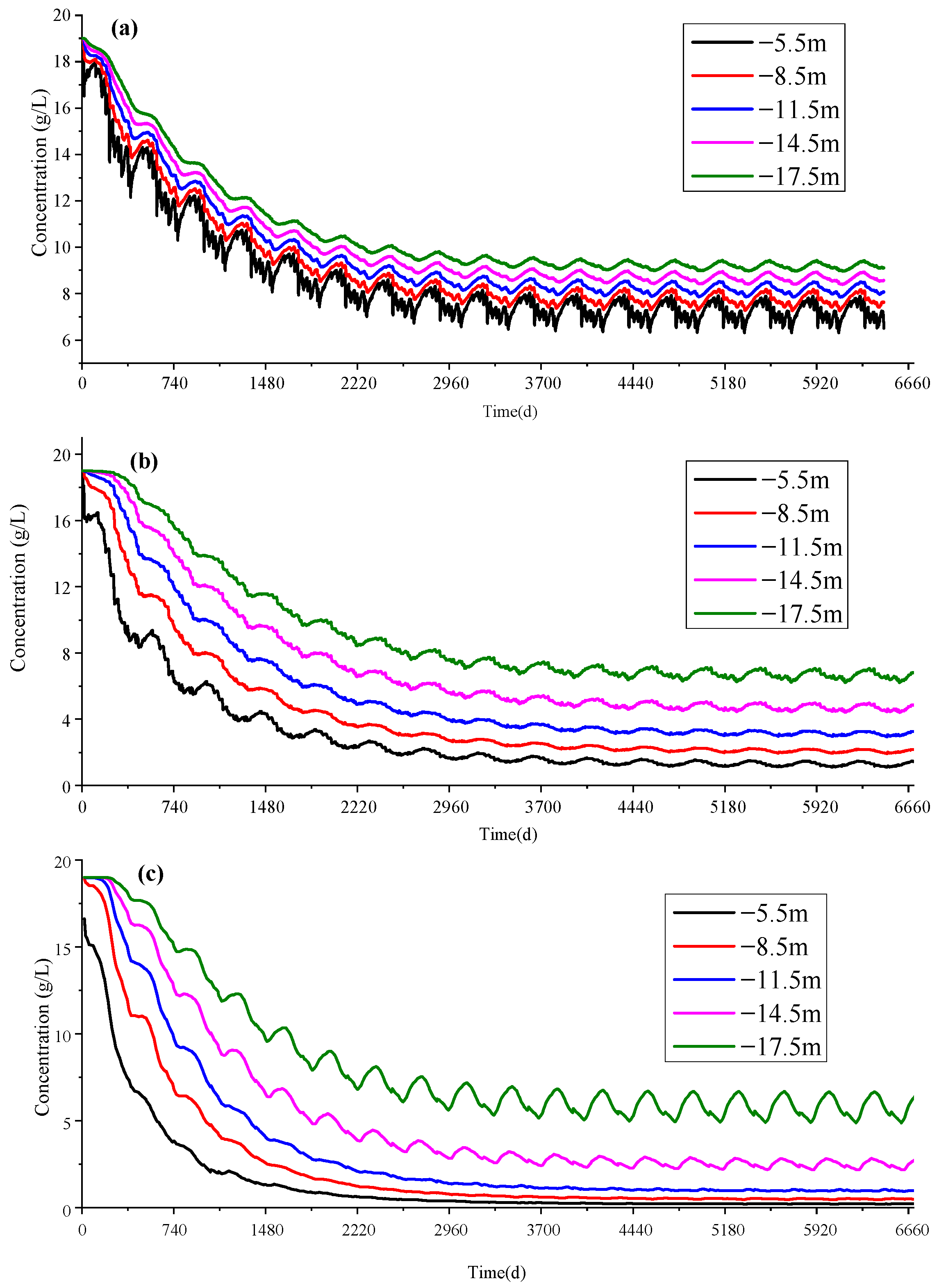
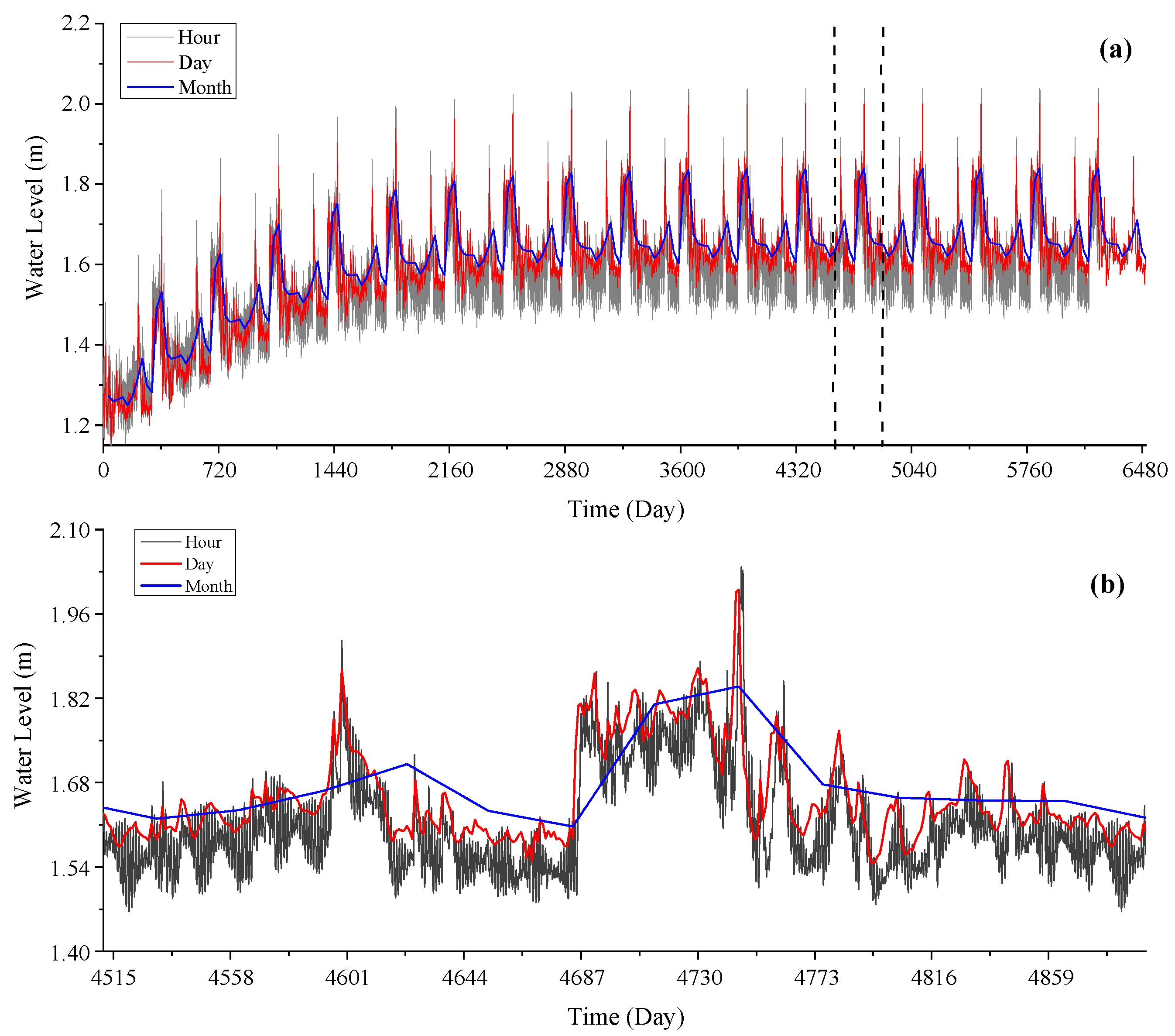
| Model Information | Description |
|---|---|
| Model elevation | −40 m to 5 m |
| Model horizontal size | 1000 m |
| Stratum structure | 5 to −20 m: coral soil layer; −20 to −40 m: reef limestone layer |
| Hydrogeological parameter | Specific yield: 0.25; dispersity: 5 m; porosity: 0.3; elastic storativity: 0.00001 |
| Permeability coefficient: 100 m/d (calcareous soil layer); 1500 m/d (reef limestone layer) | |
| Boundary conditions | Reef platform surface boundary and stratum lateral boundary: fixed concentration (19 g/L) and fixed water level boundary (1.26 m) |
| Top boundary of the reef: fixed-supply boundary (0.003722 m/d); model bottom boundary: zero-flow boundary | |
| Initial conditions | Initial water level: 1.26 m |
| Initial concentration: 19 g/L below the initial water table, and 0 above the initial water level | |
| Mesh | 100 layers vertically; 90 layers horizontally |
| Time discretization | 1 stress period, for a total of 10,800 days |
| No. | Rainfall Supply | Tidal Water Level |
|---|---|---|
| a | Uniform | Uniform |
| b | Monthly changing | Uniform |
| c | Uniform | Monthly change |
| d | Monthly changing | Monthly change |
| e | Daily changing | Daily change |
| f | Hourly changing | Hourly change |
| Simulated time: 10,800 days | ||
| Simulation Group | Stabilization Time Point (d) | Steady-State Concentration g/L | Steady-State Hydraulic Head (m) | Stabilization Time Point Error (%) | Steady-State Concentration Error (%) | Steady-State Hydraulic Head Error (%) |
|---|---|---|---|---|---|---|
| a | 4717 | 0.0012 | 1.6739 | 19.66 | 99.43 | 0.42 |
| b | 5900 | 0.1449 | 1.6771 | 0.49 | 30.64 | 0.23 |
| c | 7000 | 0.054 | 1.6783 | 19.23 | 74.15 | 0.16 |
| d | 5871 | 0.2089 | 1.681 | 0.00 | 0.00 | 0.00 |
| Simulation Group | Stabilization Time Point (d) | Steady-State Concentration g/L | Steady-State Hydraulic Head (m) | Stabilization Time Point Error (%) | Steady-State Concentration Error (%) | Steady-State Hydraulic Head Error (%) |
|---|---|---|---|---|---|---|
| d | 5871 | 0.2089 | 1.681 | 2.50 | 97.09 | 2.66 |
| e | 5862 | 1.2717 | 1.6773 | 2.34 | 82.29 | 2.44 |
| f | 5728 | 7.1812 | 1.6374 | 0.00 | 0.00 | 0.00 |
Disclaimer/Publisher’s Note: The statements, opinions and data contained in all publications are solely those of the individual author(s) and contributor(s) and not of MDPI and/or the editor(s). MDPI and/or the editor(s) disclaim responsibility for any injury to people or property resulting from any ideas, methods, instructions or products referred to in the content. |
© 2025 by the authors. Licensee MDPI, Basel, Switzerland. This article is an open access article distributed under the terms and conditions of the Creative Commons Attribution (CC BY) license (https://creativecommons.org/licenses/by/4.0/).
Share and Cite
Cui, X.; Qu, R.; Hu, M. Response of Freshwater Lenses to Precipitation and Tides. J. Mar. Sci. Eng. 2025, 13, 738. https://doi.org/10.3390/jmse13040738
Cui X, Qu R, Hu M. Response of Freshwater Lenses to Precipitation and Tides. Journal of Marine Science and Engineering. 2025; 13(4):738. https://doi.org/10.3390/jmse13040738
Chicago/Turabian StyleCui, Xiang, Ru Qu, and Mingjian Hu. 2025. "Response of Freshwater Lenses to Precipitation and Tides" Journal of Marine Science and Engineering 13, no. 4: 738. https://doi.org/10.3390/jmse13040738
APA StyleCui, X., Qu, R., & Hu, M. (2025). Response of Freshwater Lenses to Precipitation and Tides. Journal of Marine Science and Engineering, 13(4), 738. https://doi.org/10.3390/jmse13040738





